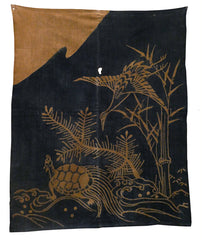An Overdyed Yuage: Tsutsugaki Dyed Cloth with Healing Properties
tsutsulate nineteenth century
32" x 25", 81 cm x 63.5 cm
This beautifully dyed cloth is laden with symbols and meaning: it is a yuage, a hand woven cloth from the Izumo area of Japan which has a long history of rich and distinctive indigo dyeing traditions.
A yuage is a towel used for babies and more than likely this was presented to a new couple upon their marriage as part of the bride's trousseau.
Yuage are typical of Izumo and are easily distinguished by a distinctive red corner, often placed on the upper left as this one was.
This yuage, however, seems to be overdyed in a warm, orange-ish tone so the distinctive red corner is not discernable, and the image, which ordinarily would have been white or undyed, now shows the same warm orange-ish tone as the area on the upper left hand corner.
Were it able to be seen, the red area would have been dyed either in benibana or safflower or in akane or madder. The reason for this area of red dye is for drying the baby's face: it was believed that safflower or madder dye would prevent small pox.
The images of crane, pine, tortoise and bamboo are typical hand resisted decorations to a yuage as they are symbols of protection to the baby: the crane, tortoise and pine meaning long life and the bamboo means resilience as it bends but does not break. Where the crane is concerned it is said that the closed beak of the crane is a sly wish for a son whereas if the beak is open it suggested a female baby. Tsutsugaki textiles of Izumo are widely discussed in the book Country Textile of Japan by Reiko Mochinaga Brandon where examples of yuage are illustrated.
There are holes on the piece, one just above center and another near the top, left corner. The hand spun, hand woven cotton is rich in texture.
Yuage are a desirable collectible textile from one of Japan's leading indigo dyeing centers and this one is a nice example with good age and it is unusual in the fact it is completely over dyed.
Recommended.


